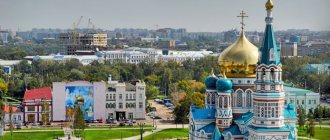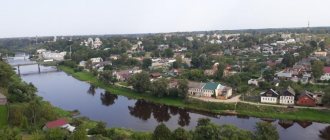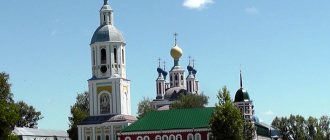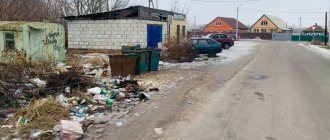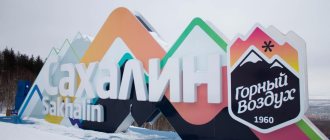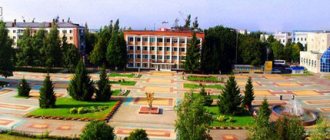general information
The name of the settlement translated from the local language means “lost place” or “swamp”. There is another version about the meaning of the name. Translated from Khanty, the name means the following: kog, koh - “long” or “long”, alyng - “beginning”. All together this is conceptualized as the “long source of the river.” Although the second version is more an attempt by the local population to at least slightly ennoble the name of their homeland.
It should be noted that Lukoil-Kogalymneftegaz (the main enterprise of OJSC LUKOIL-Western Siberia) is located on the territory of the city. It was thanks to him that this oil city appeared.
Probably not many people know that the name “Lukoil” is derived from the capital letters of Siberian cities: Langepas, Urai, Kogalym.
Big changes
In 2021, the city of Kogalym with a population of 65 thousand will experience an extraordinary event. A branch of the Maly Theater, which has not yet been represented outside of Moscow, will open here. Why in Kogalym? The city-forming enterprise helped.
“This is a version of a public-private partnership, because the branch itself is building and constructing with its own money,” Tamara Mikhailova, general director of the Maly Theater, explains to Lente.ru. She has no doubt that there will be an audience for the new stage.
“The opening of a full-fledged branch of the Maly Theater in Kogalym will allow its residents to watch plays of the same quality as in Moscow. This event will also open the doors of the theater to young local actors; we plan to hold master classes in the city,” says the artistic director of the theater, People’s Artist of the USSR Yuri Solomin.
According to Tamara Mikhailova, students will be able to show their works at the branch of the Maly Theater in Kogalym - as fourth-year students of the Shchepkinsky Theater School in Moscow usually do. But the branch’s troupe will include actors from the Moscow Maly Theater, who will be provided with apartments in Kogalym.
The building being reconstructed will house the Kogalym branch of the Maly Theater.
Photo: LUKOIL press service
Mikhailova believes that opening a branch in a small town will not only not harm the image of the Maly Theater, but, on the contrary, will increase interest in it. “We were closed for two years and traveled all over the country. In the regions, the troupe has always played those performances that are on our stage, without making a simplified version, without leaving “with two bags,” she says. When the troupe arrived in Surgut, its residents were amazed.
“We brought “Woe from Wit”, two trucks with props came with us. People took pictures of costumes, decorations, and asked about the tonnage of trucks. “All this was a shock for them,” says Tamara Mikhailova, not without pride.
However, besides the theater, there is something to see in Kogalym. The Galaktika sports and cultural complex, also built thanks to the financing of LUKOIL, houses an oceanarium where visitors can see sharks, rays, piranhas and other fish and sea animals. In addition, the complex has a water park with a wave pool for surfing, as well as cinema halls, restaurants, shops, bowling, a climbing wall, a children's skating rink and a greenhouse of seven gardens representing the flora of different zones of the world.
Cultural and entertainment, Kogalym city
Photo: LUKOIL press service
Brief history of the city's creation
Before we find out where Kogalym is located, we will present a brief chronicle of the history of the development of the city.
In the spring of 1976, the builders of the railway line landed in the taiga and set up their first tents. In August of the same year, the Surgut district committee made a decision to give the new settlement the name “SMP village N524-Kogalymsky Trom-Agansky village council.” Its emergence is associated with the beginning of the development of several oil fields.
The year 1978 was marked by the production of the first ton of oil. And the first brick house with 5 floors was built in 1981. Then various infrastructure facilities began to open at a rapid pace. And already in August 1985, the village acquired the status of a city.
Economic development of Kogalym
Kogalym, where this finally happened, began to actively develop the oil and gas industries, which are the basis of the city's economy and industry. Here are the leading production facilities of Lukoil, or rather, its main West Siberian division.
The economic well-being of a settlement depends entirely on the results of mining enterprises: annually they supply more than 30 million tons of so-called “black gold.” This amounts to 14% of all oil production in the territory of Ugra, Khanty-Mansiysk Autonomous Okrug. The volume of oil produced in this area since 1985 has amounted to 655.8 million tons. All this became possible thanks to the introduction at enterprises of new modern technologies for drilling oil wells, opening up layers, etc. Much attention is paid to geological exploration, as well as research work on the localization of resources that still have sufficient potential.
Where is Kogalym located?
In what area is the city located? It is located in the Tyumen region between two Siberian rivers: Kirill-Vysyagun and Ingu-Yagun. Administratively, it belongs to the Surgut district of the Khanty-Mansiysk Okrug.
The city is located in the northern territory of the district. The Surgut – Novy Urengoy railway passes through Kogalym. And today the main division of Lukoil-Western Siberia LLC is located here.
Where is Kogalym located geologically? It is located in the northern section of the Middle Ob Lowland of Western Siberia, in the zone of permafrost. From Khanty-Mansiysk it is 325 kilometers in the northeast direction.
Map
| Kogalym: maps |
Kogalym: photo from space (Google Maps) Kogalym: photo from space (Microsoft Virtual Earth)
| Kogalym. Nearest cities. Distances in km. on the map (in brackets along roads) + direction. Using the hyperlink in the distance , you can get the route (information courtesy of the AutoTransInfo website) | |||
| 1 | Wiggle it | 81 (100) | SE |
| 2 | Fedorovsky | 83 (165) | SW |
| 3 | Noyabrsk | 114 (107) | NE |
| 4 | Langepas | 118 (164) | YU |
| 5 | Novoagansk | 118 (442) | IN |
| 6 | Surgut | 126 (239) | SW |
| 7 | Bely Yar | 128 (249) | SW |
| 8 | Solar | 129 () | SW |
| 9 | Barsovo | 130 (251) | SW |
| 10 | Nizhnesortymsky | 141 () | Z |
| 11 | Lyantor | 141 (288) | SW |
| 12 | High | 145 () | SE |
| 13 | Rainbow | 155 (391) | IN |
| 14 | Megion | 161 (203) | SE |
a brief description of
Located in the north of Western Siberia, in the northern part of the Middle Ob Lowland, on the river. Inguyagun, in the permafrost zone, 325 km northeast of Khanty-Mansiysk.
Territory (sq. km): 201
Information about the city of Kogalym on the Russian Wikipedia website
Historical sketch
In March 1976, the builders of the railway line landed in the taiga. The first tent was set up. On August 31, 1976, by the decision of the Surgut district committee, “the newly emerged settlement of the Tyumenstroyput administration was given the name SMP village N524-Kogalymsky of the Trom-Agan village council.”
It arose in connection with the development of a group of oil fields.
The name is from Khanty koh, kog “long, long” and alyng “beginning”, which can be understood as the long source of a river.
On August 15, 1985, the village of Kogalym was transformed into a city.
Municipal indicators
| Index | 2001 |
| Demography | |
| Number of births, per 1000 population | 13.7 |
| Number of deaths, per 1000 population | 3.4 |
| Natural increase (decrease), per 1000 population | 10.3 |
| Standard of living of the population and social sphere | |
| Average monthly nominal accrued wages, rub. | 14629 |
| Average housing area per inhabitant (at the end of the year), sq.m. | 16.5 |
| Number of preschool institutions, pcs. | 14 |
| Number of children in preschool institutions, thousand people | 3.1 |
| Number of daytime educational institutions (at the beginning of the school year), pcs. | 10 |
| Number of students in daytime educational institutions, thousand people | 10.7 |
| Number of doctors, people. | 214 |
| Number of nursing staff, people. | 644 |
| Number of hospital institutions, pcs. | 1 |
| Number of hospital beds, thousand units | 0.3 |
| Number of medical outpatient clinics, pcs. | 1 |
| Capacity of medical outpatient clinics, visits per shift, thousand units. | 1.7 |
| Number of registered crimes, pcs. | 1265 |
| Persons who committed crimes were identified, persons. | 635 |
| Economy, industry | |
| Number of enterprises and organizations (at the end of the year), pcs. | 628 |
| Construction | |
| Volume of work performed by type of activity “Construction” (until 2004 - volume of work performed under construction contracts), million rubles. | 12033.6 |
| Commissioning of residential buildings, thousand sq.m. of total area | 20.4 |
| Commissioning of residential buildings, apartments | 333 |
| Commissioning of preschool institutions, places | 0 |
| Commissioning of educational institutions, places | 0 |
| Commissioning of hospital facilities, beds | 0 |
| Commissioning of outpatient clinics, visits per shift | 0 |
| Transport | |
| Number of bus routes (in intracity traffic), pcs. | 8 |
| Number of passengers transported by buses per year (in intracity traffic), million people. | 8.3 |
| Connection | |
| Number of residential telephone sets of the city public telephone network, thousand units. | 16.1 |
| Trade and services to the population | |
| Retail trade turnover (in actual prices), million rubles. | 1861 |
| Retail trade turnover (in actual prices), per capita, rub. | 33004 |
| Public catering turnover (in actual prices), million rubles. | 243.2 |
| Volume of paid services to the population (in actual prices), million rubles. | 550.5 |
| Volume of paid services to the population (in actual prices), per capita, rub. | 9760 |
| Volume of household services to the population (in actual prices), million rubles. | 76 |
| Volume of household services to the population (in actual prices), per capita, rub. | 1347 |
| Investments | |
| Investments in fixed assets (in actual prices), million rubles. | 14147.5 |
| Share of investments in fixed assets financed from budgetary funds in the total volume of investments, % | 10.1 |
Data sources:
- Regions of Russia. Main characteristics of the constituent entities of the Russian Federation: statistical collection. Goskomstat of Russia. - M:, 2003.
Main enterprises
OIL PRODUCTION INDUSTRY
LLC "LUKoil-Western Siberia"
626481, Khanty-Mansiysk Autonomous Okrug - Yugra, Kogalym, st.
Friendship of Peoples, 15 Offers:
oil, associated gas
Universities of the city
Kogalym branch of Tomsk State University of Control Systems and Radioelectronics
628481, Khanty-Mansiysk Autonomous Okrug - Yugra, Kogalym, st. Privokzalnaya, 27
Tyumen State University (Kogalym branch)
628481, Khanty-Mansiysk Autonomous Okrug - Yugra, Kogalym, st. Severnaya, 1
Branch of Tyumen State Oil and Gas University in Kogalym
628482, Khanty-Mansiysk Autonomous Okrug - Yugra, Kogalym, Naberezhnaya st., 4
Museums, galleries, exhibition halls
Museum and Exhibition Center of the City of Kogalym 628481, Khanty-Mansiysk Autonomous Okrug - Yugra, Kogalym, st. Friendship of Peoples, 40A Telephone(s): (34 667) 2-24-93 (request) 2-88-58 (ex. bureau) Website: https://www.museumkogalym.ru/
| Population by year (thousands of inhabitants) | |||||||
| 1989 | 44.3 | 2003 | 55.4 | 2011 | 58.2 | 2017 | 64.7 |
| 1992 | 48 | 2005 | 57.0 | 2012 | 58.9 | 2018 | 66.2 |
| 1996 | 51.3 | 2006 | 57.8 | 2013 | 60.0 | 2019 | 66.7 |
| 1998 | 53.5 | 2007 | 58.5 | 2014 | 61.0 | 2020 | 67.7 |
| 2000 | 54.9 | 2008 | 58.9 | 2015 | 62.2 | 2021 | 68.7 |
| 2001 | 55.7 | 2010 | 59.4 | 2016 | 63.3 | ||
Characteristics of the city, population
Kogalym is a small city. The area of its territory is 20.5 square meters. kilometers.
The head is N. N. Palchikov. It should be noted that in 1991-1993 the head of the administration was Sergei Sobyanin.
As of 2021, the population was 64.7 thousand people. Statistics in recent years show a constant increase in population.
The city has 14 preschool institutions, 9 secondary schools, and branches of three Tyumen universities. A design and research institute for oil was established in the city in 1996. In December 2011, a new Museum and Exhibition Center was opened.
Where Kogalym is located, the population composition is quite diverse. National composition: Russians - more than 57%, Ukrainians - about 10%, Tatars - more than 9%, Azerbaijanis - almost 4%, Bashkirs - just over 3%, Kumyks (Turkic-speaking people) - 2%, Chechens and Moldovans - 1 each, 6%, Avars and Chuvash - 1% each, other nations - more than 4%.
Climatic conditions
In terms of its climatic conditions, the city is equal to the regions of the Far North. The climate of Kogalym is quite harsh and unpredictable. Winter lasts almost 7 months a year, and summer is very short.
Characteristics of weather conditions:
- average annual air temperature – -2.5 °C;
- air humidity – 76.5%;
- wind speed – on average 3.1 m/s;
- Average annual precipitation is 552 mm.
In January 2006, the air temperature was minus 57 °C, and the minimum air temperature was recorded in 2009 -62 °C).
The average temperature in winter months in recent years is minus 17-18 degrees, in summer months – plus 13-17 degrees. It is important to note that city residents are plagued by the annoying Siberian midge in the summer.
Economy
Where Kogalym is located, industry is widely developed. This is a major industry that has a great impact on the standard of living of the population. Most of the residents of the city and region are employed in the mining industry, as well as in the processing and transportation of hydrocarbon products. The second type of activity is manufacturing. It accounts for about 30% of total trade turnover. This type includes:
- Production of coke and other petroleum products.
- Production of chemical products.
- Production of electronic equipment.
